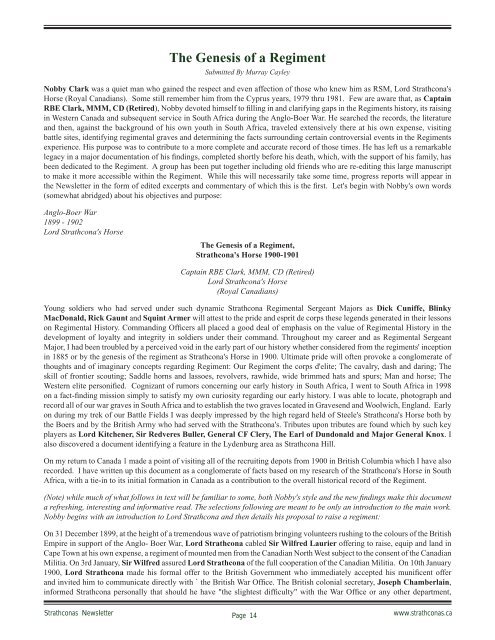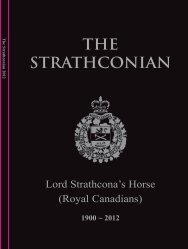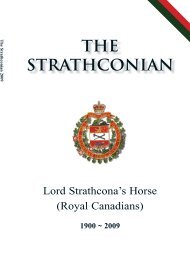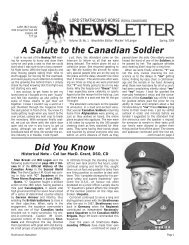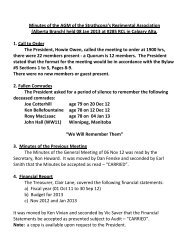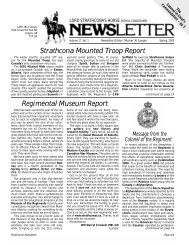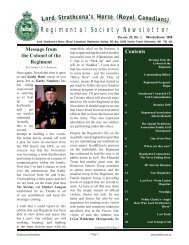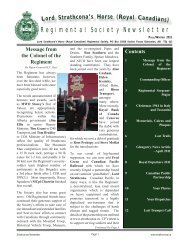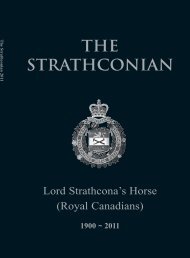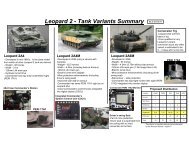Regimental Society Newsletter - Lord Strathcona's Horse
Regimental Society Newsletter - Lord Strathcona's Horse
Regimental Society Newsletter - Lord Strathcona's Horse
Create successful ePaper yourself
Turn your PDF publications into a flip-book with our unique Google optimized e-Paper software.
The Genesis of a RegimentSubmitted By Murray CayleyNobby Clark was a quiet man who gained the respect and even affection of those who knew him as RSM, <strong>Lord</strong> <strong>Strathcona's</strong><strong>Horse</strong> (Royal Canadians). Some still remember him from the Cyprus years, 1979 thru 1981. Few are aware that, as CaptainRBE Clark, MMM, CD (Retired), Nobby devoted himself to filling in and clarifying gaps in the Regiments history, its raisingin Western Canada and subsequent service in South Africa during the Anglo-Boer War. He searched the records, the literatureand then, against the background of his own youth in South Africa, traveled extensively there at his own expense, visitingbattle sites, identifying regimental graves and determining the facts surrounding certain controversial events in the Regimentsexperience. His purpose was to contribute to a more complete and accurate record of those times. He has left us a remarkablelegacy in a major documentation of his findings, completed shortly before his death, which, with the support of his family, hasbeen dedicated to the Regiment. A group has been put together including old friends who are re-editing this large manuscriptto make it more accessible within the Regiment. While this will necessarily take some time, progress reports will appear inthe <strong>Newsletter</strong> in the form of edited excerpts and commentary of which this is the first. Let's begin with Nobby's own words(somewhat abridged) about his objectives and purpose:Anglo-Boer War1899 - 1902<strong>Lord</strong> <strong>Strathcona's</strong> <strong>Horse</strong>The Genesis of a Regiment,<strong>Strathcona's</strong> <strong>Horse</strong> 1900-1901Captain RBE Clark, MMM, CD (Retired)<strong>Lord</strong> <strong>Strathcona's</strong> <strong>Horse</strong>(Royal Canadians)Young soldiers who had served under such dynamic Strathcona <strong>Regimental</strong> Sergeant Majors as Dick Cuniffe, BlinkyMacDonald, Rick Gaunt and Squint Armer will attest to the pride and esprit de corps these legends generated in their lessonson <strong>Regimental</strong> History. Commanding Officers all placed a good deal of emphasis on the value of <strong>Regimental</strong> History in thedevelopment of loyalty and integrity in soldiers under their command. Throughout my career and as <strong>Regimental</strong> SergeantMajor, I had been troubled by a perceived void in the early part of our history whether considered from the regiments' inceptionin 1885 or by the genesis of the regiment as <strong>Strathcona's</strong> <strong>Horse</strong> in 1900. Ultimate pride will often provoke a conglomerate ofthoughts and of imaginary concepts regarding Regiment: Our Regiment the corps d'elite; The cavalry, dash and daring; Theskill of frontier scouting; Saddle horns and lassoes, revolvers, rawhide, wide brimmed hats and spurs; Man and horse; TheWestern elite personified. Cognizant of rumors concerning our early history in South Africa, I went to South Africa in 1998on a fact-finding mission simply to satisfy my own curiosity regarding our early history. I was able to locate, photograph andrecord all of our war graves in South Africa and to establish the two graves located in Gravesend and Woolwich, England. Earlyon during my trek of our Battle Fields I was deeply impressed by the high regard held of Steele's <strong>Strathcona's</strong> <strong>Horse</strong> both bythe Boers and by the British Army who had served with the <strong>Strathcona's</strong>. Tributes upon tributes are found which by such keyplayers as <strong>Lord</strong> Kitchener, Sir Redveres Buller, General CF Clery, The Earl of Dundonald and Major General Knox. Ialso discovered a document identifying a feature in the Lydenburg area as Strathcona Hill.On my return to Canada 1 made a point of visiting all of the recruiting depots from 1900 in British Columbia which I have alsorecorded. I have written up this document as a conglomerate of facts based on my research of the <strong>Strathcona's</strong> <strong>Horse</strong> in SouthAfrica, with a tie-in to its initial formation in Canada as a contribution to the overall historical record of the Regiment.(Note) while much of what follows in text will be familiar to some, both Nobby's style and the new fi ndings make this documenta refreshing, interesting and informative read. The selections following are meant to be only an introduction to the main work.Nobby begins with an introduction to <strong>Lord</strong> Strathcona and then details his proposal to raise a regiment:On 31 December 1899, at the height of a tremendous wave of patriotism bringing volunteers rushing to the colours of the BritishEmpire in support of the Anglo- Boer War, <strong>Lord</strong> Strathcona cabled Sir Wilfred Laurier offering to raise, equip and land inCape Town at his own expense, a regiment of mounted men from the Canadian North West subject to the consent of the CanadianMilitia. On 3rd January, Sir Wilfred assured <strong>Lord</strong> Strathcona of the full cooperation of the Canadian Militia. On 10th January1900, <strong>Lord</strong> Strathcona made his formal offer to the British Government who immediately accepted his munificent offerand invited him to communicate directly with ` the British War Office. The British colonial secretary, Joseph Chamberlain,informed Strathcona personally that should he have "the slightest difficulty" with the War Office or any other department,Strathconas <strong>Newsletter</strong>Page 14www.strathconas.ca


